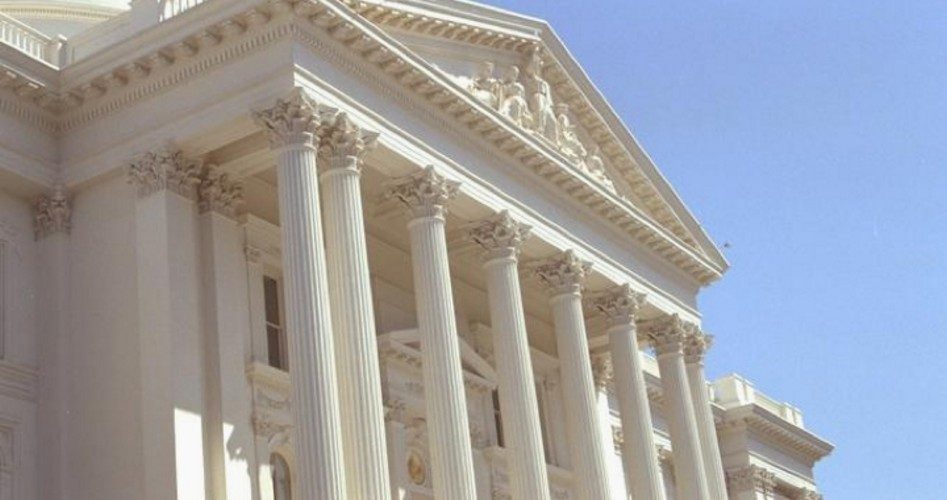
Despite the Obama administration’s claims of economic growth, the truth is that in most states the private sector is shrinking and the public sector is expanding as a proportion of the workforce. In fact, say researchers Keith Hall and Robert Greene, since the beginning of the Great Recession, the private sector has shed jobs in almost every state, while the increase in taxpayer-funded employment has been masked by the use of contractors rather than outright employees.
“In 2012,” Hall and Greene wrote in a recent report for George Mason University’s Mercatus Center, “public-sector employment made up more than 16 percent of the U.S. labor market.” That in itself is bad enough; but as the men observed, “Direct government employment fails to capture the full impact of government spending on state labor markets.”
To determine that “full impact,” Hall and Greene estimated the number of jobs in each state that are funded by federal contract dollars and added them to the number of actual public employees in that state. When they did that, they found that public-sector employment grew by almost 3.5 million jobs to a national average of 19.2 percent of the workforce. In other words, nearly one-fifth of all workers in the United States are employed either directly or indirectly by government.
The percentages, of course, vary from state to state. In some states, such as Delaware and Oregon, federal contract-funded private-sector jobs make up just 0.7 percent of the workforce. Indeed, “in more than half of the states, less than 2 percent of the labor market is employed by jobs funded by federal contract dollars,” noted Hall and Greene. In others, however, contractors account for a significant portion of the workforce: 7.7 percent in New Mexico and Maryland and 10.7 percent in Virginia. (Virginia and Maryland are in the ambit of Washington, D.C., so it’s not surprising that they get large numbers of federal contracts.)
When government jobs and federal contract jobs are combined, the picture becomes even more frightening. Only one state, Rhode Island, has less than 15 percent of its labor force collecting wages from taxpayers. Twenty-three states’ government-employment rates are 20 percent or more, and seven have rates topping 25 percent — ranging from 25.3 percent in Alabama to a whopping 31.9 percent in New Mexico, with Virginia, Alaska, Mississippi, Maryland, and Wyoming in between.
It hardly comes as a shock, therefore, that the private sector is suffering under the burden of paying for all these publicly funded employees, many of whom earn far more in wages and benefits than their private-sector counterparts. From their research, Hall and Green concluded that a full 41 of 50 states experienced reductions in private-sector jobs between 2007, the onset of the recession, and 2012. Only eight states experienced growth in private-sector employment during that time period, and of those, just three saw increases of more than two percent. One state’s (Oklahoma) private-sector employment did not change.
The three states that fared the best are North Dakota, with private-sector growth of 24.6 percent; Alaska, with growth of 6.7 percent; and Texas, with growth of 5.6 percent. North Dakota’s impressive showing is “largely due to a boom in oil production brought about by hydraulic fracturing,” wrote the online Daily Caller, which also pointed out that Texas “is often touted as one of the best states for business.” According to Forbes, the Lone Star State “is the only state that ranks in the top five for both current economic climate and growth prospects (it ranks first and second respectively).”
The five states that lost the most private-sector jobs are Idaho (6.4 percent), Alabama (6.9 percent), Florida (8.3 percent), Arizona (9.7 percent), and Nevada (13.1 percent).
With numbers like these, it’s clear that for all the talk of lower unemployment plus jobs supposedly saved by federal bailouts and created by stimulus spending, the private sector simply is not doing well.
“Our findings show that for many states, the impact of the recession and slow recovery on the private sector has been more severe than the official economic data indicates,” Hall told the Daily Caller.
ObamaCare, which greatly increases the cost of labor (already the single largest component of most companies’ expenditures), isn’t exactly helping to propel a recovery, either. Add to that mounting federal debt, unsustainable entitlement spending, “quantitative easing,” and other government policies that place America’s economic future in jeopardy, and it isn’t hard to figure out why the private sector is not just stalled but, in most states, receding.
Precisely this sort of “regime uncertainty” under the New Deal helped prolong the Great Depression, argued economist Robert Higgs, and only a massive reduction in federal spending after World War II finally spurred recovery. Having tried the same types of policies that failed 80 years ago and achieved the same results, isn’t it about time to give the same proven solution a chance?



